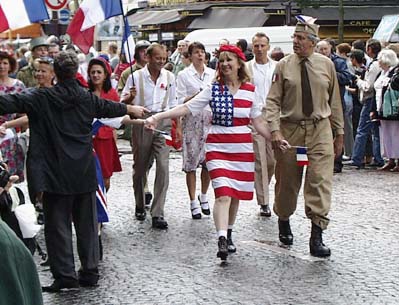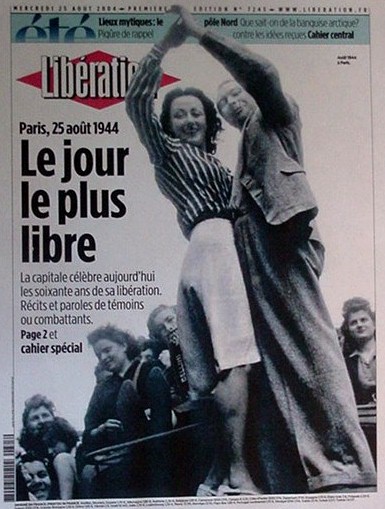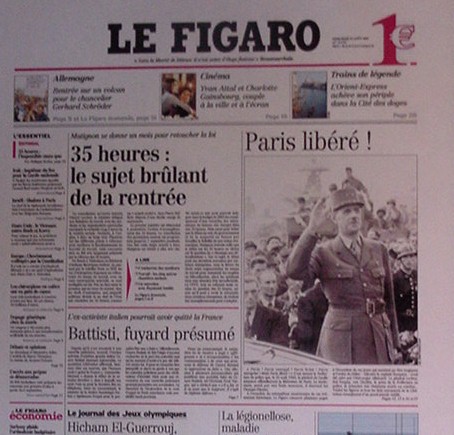
|

|
Wednesday, August 25, 2004
looking back on August 25, 1944 – sixty years after Paris was liberated from the German occupiers….
Ric
Erickson over at MetropoleParis has many details of what’s up in the city on the anniversary. Check it out.
Ric additionally sends this along
by email from the scene –
The entry of the French 2nd Armored Division was re-enacted today in front of the city hall of
the 14th arrondissement. There were Parisians costumed in WWII French and US uniforms, and as civilians were dressed in 1944.
There were scout motorcycles, jeeps, army trucks, a DUK, a half-track with four Brownings, plus some FFI rides, a firetruck
and some old Renaults and Citroens.
There was a popular band on a flat-deck and a marching band on the city hall steps.
Stage producer Jerome Savary, responsible for this evening's big dance show at the Bastille - and for organizing 1944-era
dance lessons using the Hotel de Ville ballroom as a rehearsal hall - was on hand to say a few words mangled by a defective
sound system. Schoolgirls sang a popular air of the times, and Parisians in their costumes danced, with flags fluttering.
Just as the rain started the motorcycles were fired up, to lead the ensemble out of the place and over to the Avenue
Leclerc, to make the run northwards to the city center. The heavy rain had almost stopped by the time the historical parade
reached Denfert-Rochereau, no more than 500 metres away. This place, named for a hero of the 1870-71 Franco-Prussian conflict,
was partially renamed for Col. Rol-Tanguy, leader of the FFI resistance fighters. His headquarters were located in the underground
catacombs which have their entry in this place.
The parade stalled by accident or design at Denfert-Rochereau, enabling
more Parisians to show off their recently acquired jitterbugging skills. Later the parade reached the Luxembourg, which was
a scene of heavy fighting on this day 60 years ago. The parade eventually wound through a very crowded Quartier Latin, to
the Pont Neuf.
There was a parallel parade, starting from the Place d'Italie. It represented the 4th US Army Division
that also entered Paris in tandem with the French 2nd Armored Division. Originally, it was another unit of the French 2nd
that entered Paris here, almost entirely manned by Spanish Republicans. The American division came into Paris more from the
west in 1944.
Besides a popular 'bal' staged by the French Senat at the Luxembourg Place, there was a solemn ceremony
of remembrance at the Hotel de Ville. According to today's papers there was to have been a modern military display of some
sort in the Place de la Concorde.
The stage show at Bastille tonight is also supposed to be followed by a popular
'bal' there, but the weather isn't cooperating. Live TV coverage is supposed to begin just after midnight; perhaps as a recap
of the day's festivities. Unlike the formal military parades on 14 July and 11 November, all Parisians were invited to take
part in today's parades.
And Ric sends these shots
–

|
| Click for larger image.... |

|
| Click for larger image.... |

|
| Click for larger image.... |
____
Additional
comments on the day sixty years ago from this:
60 years of memory: Paris of myth, Paris of reality
Mary Blume, International Herald Tribune (Paris) Wednesday, August 25, 2004
… Analyzing the event is like taking apart a birthday cake. What does matter is the emotion
Albert Camus described in the Resistance paper Combat: "This huge Paris, all dark and warm in the summer night, with
a storm of bombers overhead and a storm of snipers in the streets, seems to us more brightly lighted than the City of Light
the whole world used to envy. It is bursting with the fires of hope and suffering, it has the flame of lucid courage and the
glow, not only of liberation but of tomorrow's liberty."
… The past, with its defeatist generals and complaisant
Parliament who voted Marshal Henri-Philippe Pétain to power by a great majority, was unthinkable, the future unimaginable.
"I calmed down and lived wholly in the present," Simone de Beauvoir wrote. The present meant seeking heat in the Café de Flore
and cooking up her infamous turnip sauerkraut. "But previously the present had meant a happy proliferation of new schemes
in which the future bulked large; reduced to itself alone, it crumbled away into dust. Not only time but space had contracted."
… If everyone has his or her own Paris, arguably the city is most important to Americans who, unlike older civilizations,
came to it unlumbered by history, tradition or fancy lifestyles of their own. Even Ben Franklin took up flirting in Paris
in order to be à la mode; others studied science or political theory, wrote books or just loafed, moving eastward,
as Malcolm Cowley wrote, into new prairies of the mind.
It cannot be claimed that Paris welcomes foreigners, distrusting
the Other as it does, but in ignoring them it tolerates them; it is accommodating in its indifference.
"I have a feeling
that there's a voice saying take it or leave it, kid," said Mavis Gallant, who has gladly taken it. "I have lived half my
life in Paris," Gertrude Stein said. "Not the half that made me, but the half in which I made what I made."
One thing
Americans liked from the start about Paris was that while they fully enjoyed its sensual pleasures they felt they had retained
their native virtue. "We have not as much refinement, but more of everything that is good," a New Yorker wrote to his
son in the mid-19th century.
This moral self-satisfaction persists. Parisians, for the most part, don't think a lot
about high-minded ideas, these having been resolved by the heavy thinkers memorized in the lycée. Americans trumpet moral
views and find them, especially to their cost today, hard to enact. Americans want to do the right thing, not realizing it
can be plural. Parisians want to do things the right way; that is, with precision and style. This can require more discipline
than many realize: being Parisian is not a free ticket to indulgence.
The Parisian is deeply superficial, the American
superficially profound. This should balance out, but the French are more complicated than we are, as Henry James noted in
a letter telling a friend not to be put off "by what I might call the superficial and external aspect of the superficial and
external aspect of Paris."
New Yorkers are merely self-absorbed but Parisians are world-class narcissists. This is
a city made for preening, and the endless public grandstanding, physical and intellectual, may shock Americans, but in our
innermost hearts wouldn't we love to gaze at ourselves in the mirror with unabashed delight and let fall from our lips a well-timed
and irresistible mot juste?
The differences are endless, the similarities often more than skin-deep. Maybe
we all need a Paris. What Paris is, and not just for Americans, is wishful thinking come true, whatever the wish.
Sixty
years ago, the wishes ranged from the most basic (more meat) to the most lofty (peace forever). Many agreed that the thing
they had most missed was the freedom to speak. "Paris is fighting today so that France may speak up tomorrow," Camus said.
Speaking up meant daring to hope out loud. "Peace," Camus said "will return to this disemboweled earth and to those hearts
tortured by hope and memories.... Happiness, tenderness will have their moment." He was surely speaking to the dead as to
the living.
You might want to click
on the link and read the whole item.
_____
Other items of interest –
'You can't know how wonderful it was to finally battle in the daylight'
Jon Henley talks to Madeleine Riffaud, a Resistance fighter who helped save the city
Saturday August 21, 2004
in the Guardian (UK) –
August 15 1944 Paris police and
metro workers begin all-out strike, followed the next day by postal workers
August 17 German-controlled state
radio stops broadcasting; BBC reveals capture of Chartres and Orleans. Heated debate by resistance officials on when to call
uprising. Raoul Nordling, Swedish consul, negotiates prisoner exchange that frees Madeleine Riffaud. Marshal Petain, head
of Vichy government, told to leave France
August 18 Collaborationist press fails to appear. General mobilisation
of Paris declared
August 19 First fighting of the uprising. Several government buildings taken. Police occupy
their HQ. German commander Dietrich von Choltitz makes first contact with Resistance.
August 20 Street-fighting
continues. US 4th Infantry crosses Seine. De Gaulle lands at Cherbourg. Paris city hall occupied peacefully.
August
21 Street fighting. General Leclerc's 2nd Armoured Division send advance detachment to Paris. First Resistance newspapers
on sale.
August 22 Street fighting reaches peak. Barricades all over the city. US general Omar Bradley gives
Leclerc order to advance on Paris.
August 23 Von Choltitz receives order from Hitler to raze Paris to ground.
Leclerc runs into resistance near Orly.
August 24 2nd Armoured fights on. Advance detachment, escorted by Resistance,
reaches city hall in evening.
August 25 Von Choltitz signs formal act of surrender at Paris police HQ in afternoon.
De Gaulle appears at city hall.
August 26 A million people crowd Champs-Elysées for De Gaulle's victory parade.
August 31 Seat of provisional French government transferred to Paris.
From l'Agence France-Presse
(AFP) by way of The Tocqueville Connection an interesting detail here -
For the French, the liberation of Paris stands as a stirringly patriotic moment. Unlike the D-Day
and Provence landings, which were led by US and British forces, the first Allied forces the Parisians saw in the streets were
their own countrymen, followed by the Americans.
Therese Henry, 74, told AFP of her experience that day: "On the 25th
and in the days following, the Americans gave us chocolate bars with hazelnuts and almonds in them. I never again tasted chocolate
that good."
De Gaulle, the designated leader of the free French forces, marched in victory along the famed Champs-Elysees
the day after Paris's liberation, on August 26, and attended a mass in the Notre-Dame cathedral to give thanks for the city's
liberation.
On Thursday, Chirac -- who sees himself as de Gaulle's political heir -- will attend a mass at Notre-Dame,
following in his predecessor's footsteps.
And this below is good
– and contains these lines - Nick rolled his eyes when I described to him how I had held forth to Sartre. "Him big
cheese in some circles," he commented.
Paris: 1946
Paula Fox - Paris Review - Summer, 2004 - Issue 170 (with link to and interview with the author)
But Le
Nouvel Observateur (Semaine du jeudi 19 août 2004 - n°2076) at the kiosks all over Paris this week points to the future.
The past is Paris. The future is out here in California, the home of Just Above Sunset.
Here are some of the items –
Californie : Voyage au pays du future
300 km par jour pour travailler à Los Angeles
Des champignons dans le désert
Pour échapper à la saturation immobilière de L. A., les nouveaux urbains font pousser des villes au milieu de nulle part
(Yeah, folks do commute from Apple Valley to work in Los Angeles – day in and day out.)
Des puces et des
hommes
Plongée dans la société de demain
C’est l’endroit le plus high-tech de la planète mais les machines à laver y ont parfois vingt ans de retard.
Et si ce mariage du passé et de l’avenir était une des clés du génie californien?
Aime ton chien comme toi-même
Ici, on peut confier ses poissons rouges à une clinique de remise en forme et faire cloner son chat. Ici, on entend instituer
le droit au bonheur des animaux
(To paraphrase Samuel Johnson, “They shant clone Harriet.”)
Retour aux racines
Dans l’Etat le plus riche des Etats-Unis, la dernière mode est à l’ascèse, à la méditation, à la protection
de la planèteet aux plaisirs simples et bruts de la vie de pionnier
(Yes, there is a Zen ashram up in the Hollywood Hills
not far from here.)
La ruée vers l’eau
Nécessité ou gâchis, la Californie a puisé plus que sa part dans le fleuve Colorado et les lacs environnants. Devra-t-elle
se rationner?
(Always a problem here, as the city was built in a desert.)
Note also Mylène Farmer’s breathy
pop ditty has these words –
Aéroport, aérogare
Mais pour tout l'or m'en aller
C'est le blues, le coup de cafard
Le check
out assuré
Vienne la nuit et sonne l'heure
Et moi je meurs
Entre apathie et pesanteur
Où je demeure
Changer
d'optique, prendre l'exit
Et m'envoyer en Amérique
Sex appeal, c'est Sunset
C'est Marlboro qui me sourit
Mon
amour, mon moi, je
Sais qu'il existe
La chaleur de l'abandon
C'est comme une symphonie
C'est sexy le
ciel de Californie
Sous ma peau j'ai L.A. en overdose …
[You can download this in MP3 format here.]
This song from the album Anamorphosée (1995) did well in France and French-speaking Canada (saw the music
video several times when I was living in Canada and it looked as if it actually had been filmed in the courtyard of the apartment
building where I live, down by the pool). The album was recorded at the old A&M Studios six blocks east of here, on La
Brea, one block south of Sunset Boulevard. The French love California?
Oh yes, Le Nouvel Observateur has the
usual political item.
La nébuleuse anti-Bush
Pour battre le président sortant, ils organisent des concerts, lèvent des millions de dollars
et alertent des milliers d’activistes par internet. Ils ont dopé la campagne de John Kerry
Bruce Springsteen, REM, Jackson Browne, James Taylor en tournée pour MoveOn. Un joli
coup de plus pour la nouvelle star de la campagne présidentielle américaine! MoveOn? Certainement pas un groupe de rock, encore
moins un parti, et à peine une organisation: avec seulement quatre permanents, mieux vaudrait parler d’un réseau. C’est
pourtant cette nébuleuse de 2 millions de membres qui a convaincu le Boss et ses potes rockers de se lancer dans une série
de concerts pour un «Vote for change». Les concerts anti-Bush, annonce Eli Pariser, le directeur de MoveOn, constitueront
«la sonnette d’alarme pour l’élection la plus importante de notre vie»…
MoveOn et consorts sont-ils
en train de réinventer le Parti démocrate et la politique américaine en général? Trop tôt pour le dire, mais le mouvement
a largement dépassé le stade de l’épiphénomène. Quand Howard Dean s’est pris une raclée lors des primaires, début
2004, on avait beaucoup ricané sur cette nébuleuse internet qui le soutenait. Cette frange d’électeurs plus jeunes et
plus à gauche que l’ensemble de la population n’avait pas pesé lourd devant la volonté générale de désigner un
candidat centriste crédible face à Bush. Mais John Kerry s’est empressé d’emprunter à la campagne Dean son savoir-faire
pour la levée de fonds par internet. MoveOn, ACT (America Coming Together) et une nébuleuse de «comités d’action politique»
ou de «groupes de pression» ont pris une importance chaque jour plus grande dans cette campagne.
A l’exception
des partisans de Ralph Nader, toute la gauche est aujourd’hui rangée sous la bannière ABB (Anybody But Bush –
n’importe qui plutôt que Bush). …
You get the idea.
But back to the past – Wednesday’s French national
dailies. –



|

|

|

